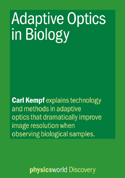By Matin Durrani
For centuries, astronomers looking up at the heavens through a telescope had a problem on their hands – the quality of their images depended on the strength and direction of the wind in the air. Trouble is, the Earth’s atmosphere isn’t uniform because its density – and thus its refractive index – varies from point to point as the wind blows. Result: distorted images.

Carl Kempf’s new short-form Physics World Discovery ebook is free to read
In 1953, however, astronomer Horace Babcock proposed a clever solution, which was to bounce incoming light off a device that can rapidly correct for changes in optical path-length, which flattens the wave-front and so counteracts the effects of aberration. Any remaining wave-front errors are measured after the correction, before a feedback control loop uses the measurement to continuously adjust the corrections applied to the wave-front.
That was the principle behind “adaptive-optics” technology, which has since gone on to become a routine and invaluable part of astronomy. Turns out, however, that the same principles can be used in microscopy too, leading to many applications of adaptive optics in medicine and biology too, as I’ve discovered by commissioning and editing a new short-form Physics World Discovery ebook by Carl Kempf.
Kempf is a senior systems engineer at the California-based firm Iris AO, Inc, which is heavily into adaptive-optics technology, having worked on sensing, actuation, and control systems for high-precision devices for more than 30 years. I’m pleased to say that Kempf’s short ebook, Adaptive Optics in Biology, is now available for you to read free in EPUB, Kindle and PDF format via this link.
To give you some more idea of what the book is about and his career to date, I put some questions to Kempf, which you can read below. Don’t forget either that there are plenty of other books in the Physics World Discovery series, ranging from multimessenger astronomy to quantitative finance.
1. Carl, can you tell us about how you ended up working for Iris AO?
My background is in control systems, and adaptive optics is an interesting area that a lot of traditional control engineers overlook. When the chance to build the controller for the Iris adaptive-optic mirror came along, I couldn’t resist.
2. What does the firm mostly do and what’s your role there?
The company’s core product is a family of deformable mirrors build using techniques from micro-electromechanical systems (MEMS). Unlike most other mirrors, the devices have an optical surface that is an array of individual hexagonal segments. This offers some significant advantages, but requires a little bit of sophistication in the controller design. We also build some closed-loop systems our customers can use in simple applications or use a starting point for their own development of more sophisticated systems. My role is to oversee the development of the electronics and software that our customers use.
3. Why do you find adaptive optics such an exciting technology?
First, it is just such a simple but clever idea. As an engineer, I appreciate that. Second, to see an image sharpen up dramatically when the adaptive-optics controller is turned never gets old. It is just a neat thing to see.
4. What’s been your favourite application of it so far?
Probably retinal imaging. Being able to see details like blood flow in real time is fascinating. There is so much complex biology at work in the eye it is really pretty amazing to me, particularly coming from an engineering background. Knowing that the technology we build enables this is rewarding. Another aspect is that researchers often image themselves when first testing out a system, just because we are readily available. Taking these hi-tech “selfies” is fun.
5. Why would you encourage other scientists to take an interest in the field?
Adaptive optics is basic enabling technology that is going to be present in all the highest performance optical imaging systems regardless of whether it is astronomy, biology, or other fields. A basic knowledge of what adaptive optics is and how it works is useful to a scientist, particularly if they are lucky enough to get some time on an adaptive-optic-equipped system.
You can read Kempf’s Physics World Discovery book Adaptive Optics in Biology completely free via this link. For all titles in the series, please go here.

Guidelines
Show/hide formatting guidelines
this text was deletedwhere people live in harmony with nature and animals</q>
Some text